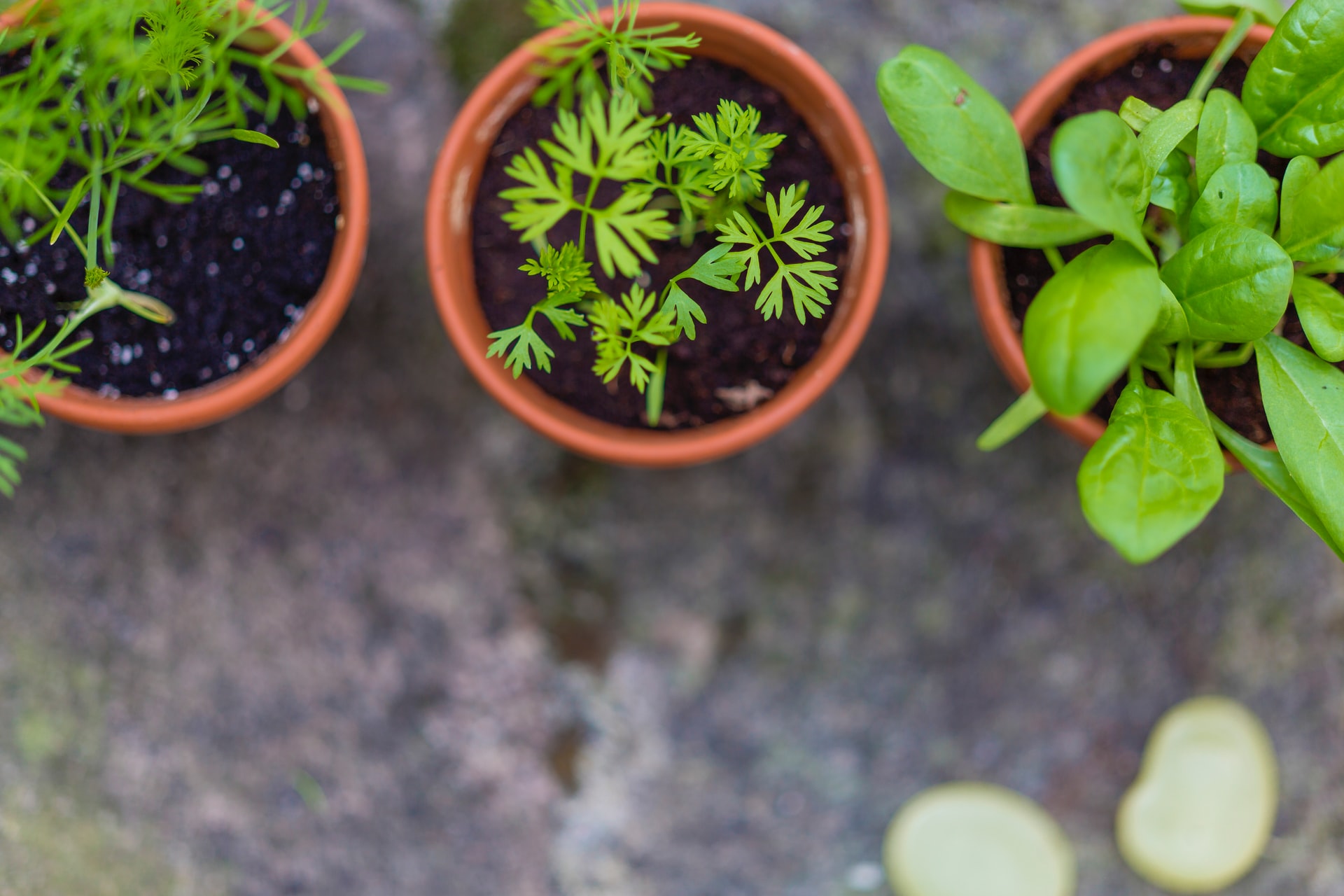Using herbs and spices in the kitchen is a fun, rewarding activity to keep everyone entertained. It’s relatively easy to grow herbs and create your own spice mixes without needing a lot of materials. However, you would want to have some basic knowledge before getting started to ensure your plants grow well and know the best use of herbs and spices in the kitchen.
Herbs and spices have many uses and benefits. It can be added to your mix or condiments to flavor your food. Many combinations are available, whether you’re looking for a rich flavored mix or something more simple. Depending on the herbs and spices you use, it can also provide health benefits; for example, ginger can treat nausea, and garlic is known to improve heart health. Therefore, making them suitable for your healthy lifestyle.
Whether you have a garden or live in an apartment, there are many ways to grow herbs indoors and outdoors. Or, if you want to grow herbs in the winter, there are various options, such as using windowsills. Read on to find some great tips from experts and start growing herbs and using herbs and spices – all from the comfort of your home.
What are your top tips for using TIMUT Pepper in the kitchen? What are good herb combinations with this pepper?
The conversation around food is booming, and cooking is about experiencing new tastes, which is the enhancement to everyday cooking people are looking for today! Bon COOK’s conversation today is around top tips for using TIMUT Pepper. To answer the question: What are the top tips for using TIMUT Pepper? We suggest getting creative and knowing that with this pepper’s fruity notes and zing, its ability to infuse flavor in Pork or Chicken is outstanding! With the fruity notes and pungent bite, whether roasting or grilling pork or chicken, TIMUT does not disappoint! What herbs are best combined with TIMUT Pepper?
TIMUT Pepper also lends a surprising boost to salads and fish with its grapefruit flavor and zing sensation. You will find an unexpected increase of flavor when paired with fresh herbs, and we especially love when paired with Cilantro, Dill, Parsley, Mint, or Basil. We suggest prepping your herbs by adding a slight drizzle of olive oil and then adding the TIMUT pepper to your herbs and tossing it before adding it to your recipe. This added step gives the pairing of pepper and herbs the flavor boost that pepper lovers crave. Want to pair TIMUT with spices, this versatile pepper is delightfully paired with Cinnamon, Turmeric, and Ginger.
– Cindy, Bon COOK
Which herbs and spices go well together in cooking?
Spices such as red chili, turmeric, and cumin are commonly used in their dry form in South Asian recipes and go exceptionally well with fresh green coriander leaves.
And which combinations would you not recommend?
It’s difficult to go wrong when experimenting with combinations of herbs and spices but to maintain the authentic flavors of a specific regional cuisine; we probably wouldn’t recommend using a herb such as fresh basil in a Chinese-inspired stir-fry dish that uses ginger and green chili.
– Sheryl, TastePak

What are the easiest herbs to grow at home?
Herbs, in general, are pretty easy to grow because most thrive on inattention and even a bit of neglect. Since many originate in the Mediterranean, they prefer dry, sandy soil and little in the way of soil fertilizer or amendments. It’s best to grow the culinary herbs you enjoy using in your cooking, but some good choices to grow from seed or seedling include basil, cilantro, dill, oregano, parsley, rosemary, sage, and thyme. Herbs should be trimmed throughout the growing season, picking the largest leaves from each plant, but never more than 1/3 of any plant to allow it to continue to grow.
Why is the windowsill the most recommended place to set up your indoor herb garden?
Growing herbs indoors is simple. Whether you plant some seeds directly in the soil in a small pot, replant an herb plant from outside, or even root a cutting from one of your plants in water, setting the pots on a sunny windowsill will ensure success. A south-facing window is best, so the plants get full sun most of the day. Leave space between the pots, so the plants get good air circulation between them and aren’t crowded. Try to keep the room temperature between 55-75 degrees. Potted herbs should be watered every few days, preferably in the morning when it’s cooler, to allow the water to penetrate the soil and not evaporate as quickly. Water the plants when the topsoil is dry to the touch.
– Lisa, Fresh Eggs Daily
How Do You Know The Amount of Water Your Herbs Need?
Garden herbs require quite a good level of care and nurturing to produce at their best. One way to give this nurturing to the plants is by watering them. However, as much as watering the plants is essential for their growth, you do not want to overdo it or underdo it.
It is quite easy to know the amount of water your herbs need. Below’s how to do that:
- All you have to do is feel the soil. Typically, you water your garden herbs once a week.
Nevertheless, if you’re not satisfied with the amount of water the plant is getting, try to feel the soil. By feeling the soil, you’re checking for moist or excessive dryness.
If the soil is still moist or not completely dry, then do not water the plant.
If, however, the soil is very dry and seems to be very hard, you can always add a good amount of water to the plants.
Can you mix fresh herbs with dry herbs to make a DIY Seasoning?
Adding herbs to foods not only adds flavor but it’s also healthy. “When you’re cooking with herbs, you’re cooking for health in many different ways,” says Marilyn Trownsell, registered dietitian and member of the Old Dominion Herb Society in Virginia. Herbs contain small amounts of vitamins and minerals, plus they’re a tasty source of antioxidants.
The best seasoning blends include at least five spices and herbs. Although you can easily purchase excellent blends, it can be satisfying to make your own instead for at-home use or gifts. For DIY, you can combine your homegrown herbs with store-bought dried herbs, though blends using fresh herbs are less shelf-stable than blends using dried herbs. If you mix fresh and dried herbs, remember that dried are more concentrated than fresh, so you’ll use less. As a general rule of thumb, 1 tablespoon fresh = 1 teaspoon dried leaves or flakes = ½ teaspoon dried ground herbs.
– Annie, BOOMER Magazine
What tips do you have for growing herbs in the winter? Is the windowsill only a good idea for winter or all year round?
Herbs tend to need lots of light to thrive. Think of Italian basil, Indian mint, Mexican coriander… Herbs like bright light, and lots of it! Ideally, herbs need upwards of six hours of sunlight a day. If they don’t have enough sun, they can grow spindly and start to pack less of a flavor punch. In winter’s short days, a small grow light can help keep your herb plants happy – especially if you live further north. It’s lovely to keep herbs on a windowsill all year round, so they’re at hand when you need them. In summer, keep an eye on them to ensure they don’t get too hot and dry. Some, like basil, can scorch. They need plenty of moisture too, to keep growing those tasty leaves.
– Alison, Burgon & Ball

How important is lighting when growing herbs, and what tips do you have for beginners?
Many herbs are native to Mediterranean regions and are accustomed to abundant light and arid conditions. These herbs include Tarragon, Sage, Rosemary, Thyme, and others.
Light and water are the two most essential ingredients when growing most plants, so before purchasing potted herbs or starting them from seed, research how much light they need. This way, you can determine whether you have the right conditions to grow them.
If you want to grow an herb garden in your kitchen consider a countertop lighting system, readily available online or at some home centers. They usually consist of a tray for your plants with a plug-in grow light that hangs over it. The type of bulb is important, with fluorescent and LED being the two most often used. They’re both cool lights with a long life. It’s best to get full spectrum, so they have both red and blue light in them, which is suitable for growing plants. If you don’t have room in your kitchen, you can put your herb garden in an out-of-the-way place such as your basement or garage. The grow lights will replace the need for natural sunlight.
– Dorian, Womanswork
What is an easy, flavourful Indian spice blend?
Chicken Masala is the zingy motley of aromatic Indian spices. The finely ground spices add a distinct hot ‘n’ fiery flavor to any delicacy you wish to use it for. Paneer Tikka, chicken delicacies, chickpeas, or even dry recipes (without any curry), can be spruced up to a heavenly flavor by adding the right amount of this tantalizing blend. Let’s find how you can make this aromatic mix at home-
Ingredients
- Coriander Powder-1 tablespoon
- Paprika Powder or Kashmiri Chilli Powder– 1 & a 1/2 tablespoon
- Turmeric Powder-1/4 teaspoons
- Fenugreek Powder-1/4 teaspoons
- Cardamom Powder– 1/4 teaspoons
- Cumin Powder-1 teaspoon
- Ground Black Pepper-1/4 teaspoons
- Ground Nutmeg- 1/4 teaspoons
Mix all the spices well. You can either use the mixture immediately or store it in an airtight container for later use.
Note: This recipe yields around 3 & 1/2 tablespoons of Chicken Masala. For a fresher and crunchier spice mix, it is recommended to use the whole spices. You can use a Spice-grinder to grind the whole spices into a fine powdered mix.
What herbs are most useful for when you’re sick?
When the cold and flu season hits, we are looking for herbs that ease a cough, soothe a sore throat, and boost our immunity, so we get back our strength and feel better soon. Herbal infusions are gentle yet powerful. They work slowly over time to fortify the body with vitamins and other nutrients. You can also make tea blends and combine various herbs to achieve better results. You can just drink astragalus, elderflowers, or elderberry infusions for prevention. Their antiviral and anti-inflammatory properties help you boost the immune system and fight infection.
I like to use linden (Tilia cordata) to ease the cough, sore throat and induce sweating. In addition, thyme (Thymus vulgaris), pine, and anise with essential oils, minerals, and vitamins help boost the immune system and increase mucus production. Marshmallow root, which has been used to ease cough and sore throat since ancient times, contains mucilage that coats the throat and soothes irritation. If one suffers from dry or asthmatic cough adding ginger to your infusion may soothe the cough and relieve nausea and pain. Primrose (flos primulae) or liquorice root (radix liquiritieae), on the other hand, contain saponins that increase bronchial secretion, thus helping to ease productive or chest cough rather than the dry.
– Vladka, Simply beyond herbs
What are the best spices for sweet dishes?
Spices added to desserts can really elevate the flavor, cinnamon is probably the most popular used in recipes like cinnamon rolls and apple pie. But then there is my most favorite nutmeg which is delicious in pies, crumbles, and French toast. And lets not forget allspice which can be used in both savory and sweet dishes and is a great substitute for cloves.
– Wendie, Butter Your Biscuit

What are the basic spices needed for Indian cooking?
One of the intimidating things about Indian cooking is the variety of spices used to prepare a dish. Every Indian house has a masala box in its kitchen in which they keep some of the basic spices used every day. The use of spices varies from region to region but the basic steps remain the same. In an Indian masala box, you will find Cumin, Mustard seeds, Hing, Haldi Powder, Red Chilli powder, Dhania powder, and Garam masala. These are ingredients you use in the daily cooking of Indian dishes. Though North Indians prefer to use cumin while South Indians mostly use mustard seeds for tadka. Along with this, there is a variety of other spices that you keep in the kitchen and use according to the recipe such as dalchini, cardamom, kali mirch, kasoori methi, laung, methi seeds, tej patta, fennel seeds, saffron. Indian also keep different type of masala powder like sambar masala, channa masala, paoo bhaji masala, kitchen king in the kitchen.
– Simmi, RitiRiwaz
What are the basic staple ingredients for homemade dips?
There are 3 main components to homemade dips. Most of these are common ingredients that most kitchens might carry. The base, spices, and herbs. The base can consist of either sour cream, mayonnaise, cream cheese, or yogurt. There are many different spices that can be added to dips to enhance the flavors. The most basic of those are salt, pepper, and garlic powder (or whole garlic). Likewise, there are many herbs used in a variety of dips. The most common are parsley, chives, dill, or garlic.
Check out these dips recipes:
– Dina, Simply Home Cooked
How should mixed spices be stored?
Mixed spices should always be stored in an airtight container. I store them in a small mason jar. Note the date on the spices you are mixing, the early expiration will also be the expiration date of your mix.
– Taryn, Joy Filled Eats
What’s your best advice to dry herbs at home?
- Pick herbs in the morning after the dew has dried, but before the day’s heat has set in.
- Wash the herbs gently, pat them dry, and remove any yellow or damaged leaves.
- Bundle herbs together with a rubber band or string and hang them in a dry, dark, and airy place with good circulation, such as a pantry or closet.
- Place herbs on a screen or drying rack in a single layer, and make sure they don’t touch.
- Turn the herbs regularly to ensure even drying.
- Depending on the humidity and temperature, it can take several days to several weeks for herbs to dry completely.
- Once the herbs are completely dry, crumble or grind them and store them in airtight containers away from light and heat.
– Triona, Green Goddess
What are common herbs and spices used for seasoning meat?
There are dozens of herbs and spices for meat. It really depends on the flavor profile you are going for. To enhance the flavor of the meat stick with just salt, pepper, and garlic powder. For a Mexican vibe, add cumin, chili powder, onion powder, and a tiny bit of oregano. If you want more of an Italian flavor, add basil, oregano, parsley, and extra garlic. For an herb rub, choose rosemary, thyme, sage, basil, and parsley.
– Taryn, A Grill for All Seasons
What herbs are great to use in side dishes?
What are some tips to grow herbs hydroponically?
- Make sure the temperatures are between 65 – 80 degrees inside the grow system.
- Use nutrients that auto-PH like Advanced Nutrients.
- Use a complete grow system like Dealzer Grow Boxes or Galaxy Grow Tents.
- Use clean water only. Distilled, reverse osmosis, or bottled water work.
What are the benefits of using seed starter kits to grow herbs indoors?
What are the benefits of Chinese herbs?
Chinese herbal medicine is part of a larger healing system called Traditional Chinese Medicine (TCM) and utilizes an assortment of mineral, plant, and animal products to treat various illnesses. TCM uses natural methods to enhance the body’s ability to repair itself, maintain health, and prevent disease.
Throughout history, people have noted different herbs and plants that could be eaten for their medicinal properties. The Chinese were among the first to document the effects of such natural remedies. Huang Ti, or the Yellow Emperor (2,696 to 2,598bc), is reputed to have discovered the secrets of herbal medicine as well as invented a system of writing to record his findings.
There is some debate as to whether the Emperor ever really existed but his book, called the Huang-ti Nei Qing Su Wen (The Yellow Emperor’s Classic of Internal Medicine), certainly does. More than just a textbook, it’s a manual for living and covers topics such as Tao, Yin & Yang, and the Five Elements.
A number of other books concerning health were written over the following centuries, but it’s the Yellow Emperor’s Classic that has continued to be a core source of information on Chinese medicine in modern times.
– Aunt Agga, Feng Shui
What are the benefits of herbal tea?
Aside from its refreshing taste, herbal tea is steaming with benefits — the biggest being that it’s caffeine free. It’s made from a blend of natural herbs, spices, and other plants steeped in water. Herbal teas are packed with antioxidants, giving those who consume them an immune system boost. In general, they can aid in digestion, reduce inflammation, and even help reduce stress and anxiety. That list of benefits can increase depending on the kind of herbs used to make your tea. Mint tea, for instance, can help alleviate headaches and relieve nausea. If you’re looking for a natural remedy to soothe pain and improve body functions, try adding herbal tea to your diet.
What are the benefits of herbs for everyday health?
Many spices and herbs provide a variety of different health benefits. These include anti-inflammatory properties, brain boosting effects, as well as having antimicrobial capabilities.
Using herbs for their health benefits isn’t new. Ancient mankind used a multitude of botanicals for their various healing effects. It has been noted that Hippocrates, the father of medicine, used saffron, cinnamon, thyme, coriander, and other herbs to treat various illnesses.
New research shows that these herbs that have been used for millennia still provide benefits today. Some of the best herbs for everyday health include turmeric, ginger, cumin peppermint, echinacea, and cinnamon.
-Daniel, The Botanical Institute

So if you want to grow your herbs and use them along with spices to enhance your cooking skills, take these expert tips and get started. Not only will you have some green around the house, but you’ll also have your homemade ingredients to enhance the flavor of your food. Besides the tremendous herb-spice combinations mentioned above, don’t be afraid to try something new.
This Q&A is still developing.




